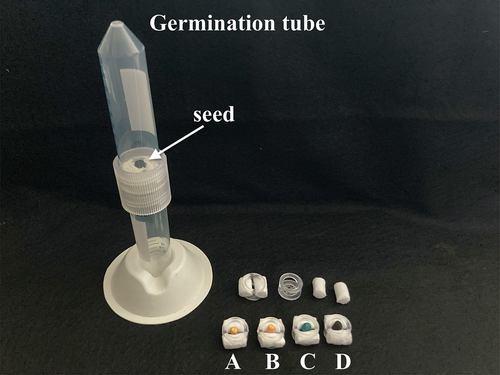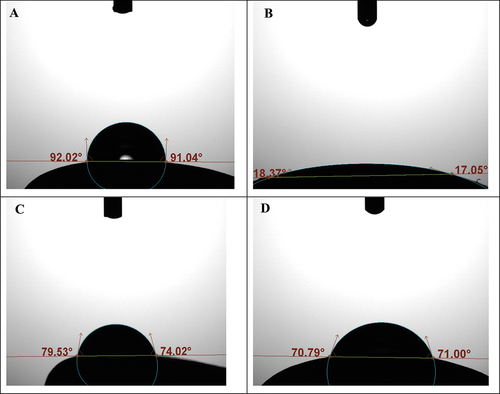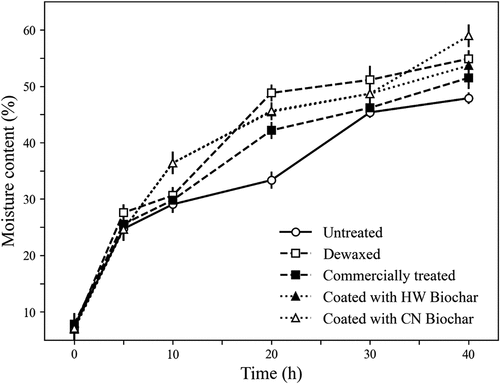Figures & data
Table 1. Selected properties of the two biochar types used in the study
Figure 1. Corn seed germination and seed water uptake studies were carried out using a specifically designed test tube system (left). Seeds (A: control; B: dewaxed; C: commercially treated; D: biochar treated) were secured between two cotton plugs at the junction of two test tubes held together by a threaded sleeve created with a 3D printer.

Figure 2. Examples of measurement of the apparent contact angles of sessile water drops on the surface of untreated corn seeds (A) and seeds that were coated with the hardwood biochar (B). Measurements were also conducted on samples of corn seed that were coated with a commercial polymer (C) and seed which were subjected to the removal of the external waxy layer (D, dewaxed seeds).

Figure 3. Water uptake by untreated corn seeds (control) and by seeds that were coated with hardwood (HW) or coconut (CN) biochar. Measurements are also included of samples of seed that were coated with a commercial polymer and seeds that were subjected to the removal of the external waxy layer (dewaxed seeds). Each point represents mean ± STD (n = 3).

Table 2. Wettability of corn seeds was measured as reduced apparent contact angle of sessile water drops on the surface of seeds that were either untreated (control) or subjected to treatments with two types of biochar (hardwood, HW, and coconut, CN, biochar). Measurements included samples of seeds that were coated with a commercial polymer and seeds that were subjected to the removal of the external waxy layer (dewaxed seeds). Data are presented as mean ± STD. Values followed by the same letter are not significantly different (P < 0.05; LSD)
Table 3. Germination and mean germination time of untreated seeds (control) compared with seeds that were coated with hardwood (HW), coconut (CN) biochar, a commercial polymer or seeds which were subjected to removal of the external waxy layer (dewaxed seeds). Data are presented as mean ± STD. Values followed by the same letter in the same column are not significantly different (P < 0.05; LSD)
Table 4. Aspergillus flavus propagules recovered during the germination process from untreated (control) seeds, and from seeds coated with hardwood (HW) biochar, coconut (CN) biochar, commercial polymer or subjected to the removal of the external waxy layer (dewaxed seeds). Data are presented as mean ± STD. Values followed by a letter are not significantly (P < 0.05) different from other values followed by the same letter (ANOVA)
Table 5. Size of the soil Aspergillus flavus population and percent aflatoxigenicity of isolates recovered from plots planted with untreated corn seeds and corn seeds coated with one of two types of biochar (hardwood, HW, and coconut, CN). In both years, samples were collected at the beginning (Apr.) and at the end (Sept.) at the end of the corn growing season. Aflatoxin contamination of harvested corn kernels and yield are reported. Data are presented as mean ± STD. For each year, values followed by a letter are not significantly (P < 0.05) different from other values followed by the same letter (ANOVA)
